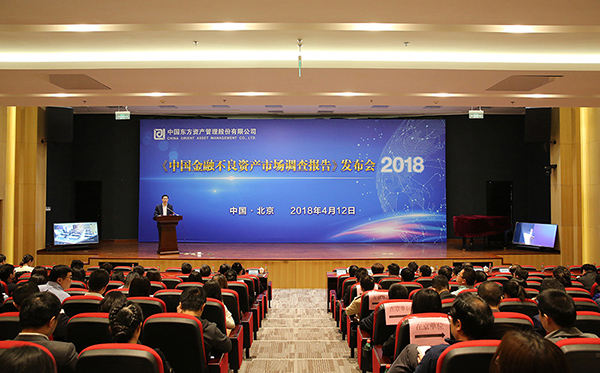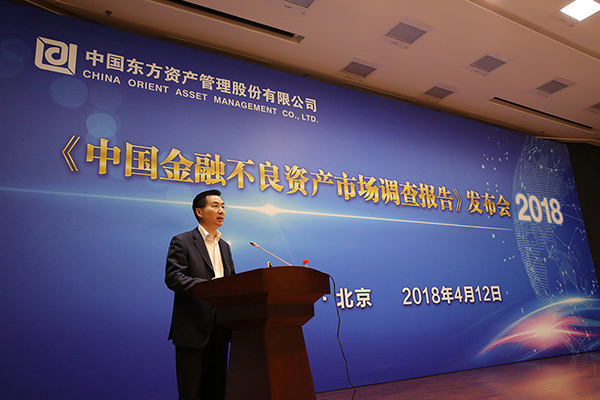


On April 12, the Survey Report on China’s Financial Non-performing Asset Market (2018) was released in Beijing.
As an annual report researched and developed by China Orient Asset Management Co., Ltd., the Survey Report on China’s Financial Non-performing Asset Market (2018) adopts the empirical research method integrating questionnaire survey and data analysis, aiming to predict the future development trend of China’s non-performing asset market through data mining and model analysis based on the opinions and judgments of relevant participants and researchers on financial non-performing Asset market. The report has been released for 11 consecutive years since 2008, filling the gap in the research field of non-performing assets in China and producing a positive social impact.
Updated on the basis of all its previous versions released over the past decade, the Survey Report on China’s Financial Non-performing Asset Market (2018) doubles the number of industry respondents and includes the investigations on another 50+ senior experts in economic and financial fields, striving to, through the third eye, reflect the situations of China’s non-performing asset market in a more neutral, objective and comprehensive way. The investigation period of this report is from late November to early December, 2017, during which the research team designed questionnaires respectively for practitioners in commercial banks and asset management companies and relevant economists, and obtained a large number of first-hand data finally; through statistical analysis and organization of such data, the team summarized a series of views of experts and scholars in the industry on China’s financial non-performing asset market, and it also predicted the development trend of China’s financial non-performing asset market using public data and the model it established.
The results of the questionnaire surveys against respondents from commercial banks, asset management companies and external experts and scholars show that all the respondents express similar opinions on macroeconomic growth and market trend. For example, most of them thought that China’s economy would maintain steady growth in 2018, with the growth rate being above 6.5%; monetary policy would remain stable and tight, and the strengthening of financial sector regulation would continue; risk prevention would maintain the top priority, and asset management businesses, interbank finance, financial holding companies and Internet finance would be subject to stricter supervision; with the deepening of supply-side structural reform, bank credit risks would continue to be exposed, and the scale of non-performing asset market would probably be further expanded in the next three to five years.
A majority of respondents from commercial banks believed that the overall credit quality of commercial banks would slightly improve in 2018 due to multiple factors, but the quality of credit assets in the real estate sector may decline. Most respondents tended to believe that in 2018, it would be more urgent for commercial banks to dispose of non-performing loans, the exposure of risks regarding non-performing loans would accelerate, the actual non-performing loan ratio may be higher than the published data, and the non-performing loan ratio of commercial banks would likely to peak in 2020. They also held the opinion that in 2018, commercial banks would focus on reducing the non-performing loan ratio, external transfer of non-performing assets would be the most effective measure, and more attention would be paid to the securization of non-performing assets.
Most of the respondents from asset management companies thought that in the primary market of non-performing assets in 2018, with the increase in the number of buyers, the competition among buyers would become increasingly fierce, and the characteristics of seller’s market would become more significant; in the secondary market, the development, specialization and marketization degrees of the secondary market would continue to improve, non-performing asset management units would appropriately speed up the disposal of non-performing assets, and private enterprises would become the main investors in the non-performing asset market. In the future, the businesses regarding creditor’s rights will still be the main source for businesses of asset management companies, and for non-financial institutions, the “blue ocean” of non-performing asset business will present more business opportunities. Asset management companies still prefer acquiring distressed debts regarding real estate. The four asset management companies, relying on their strong capital strength and professional advantages, still occupy a dominant position in the non-performing asset market, local asset management companies show significant advantages locally, and the institutional structures in the non-performing asset market will develop further toward the direction of multiple levels, different advantages and high-degree division of labor.
The experts and scholars interviewed generally believed that financial regulation in 2018 would gradually transit from the control of risk increment in 2017 to the disposal of risk stock. In 2018, institutional reform centering on the three key circulations (support of finance to the real economy, internal circulation of the financial industry and finance and real estate) concerning the operation of national economy will develop from the stage of research to that of gradual implementation. Local governments and state-owned enterprises become the most prominent subjects of debt leverage risks under heavy structural deleveraging pressure. The main cause for the formulation of this round of non-performing loans in banks is economic restructuring, seconded by weak risk control of financial institutions and administrative intervention. With the increase in the number of buyers in the non-performing asset market, the irrational surge in the price of some non-performing asset packages recently may make non-performing asset operation institutions encounter new difficulties and lead to new risks.
Overall, the non-performing asset market survey, with rich contents, rational views and objective conclusions, can closely track policy dynamics and market changes, and will play an active role in helping the industry deeply understand the non-performing asset market, and grasp the trend, promote the formation of consensus and advance the development and improvement of the market. Under the overall situation that financial supervision is becoming increasingly strong and strict, and regulatory policies against the non-performing asset industry are subject to adjustments and changes, the non-performing asset market will gradually become rational and mature with the gradual expansion of its scale, the increasing number of its participants, the continuous presentation of business opportunities regarding non-performing assets of nonfinancial institutions and the intensification of industry competition.

Wu Yue, president of China Orient, said at the release conference that in face of new situations, China Orient would stay true to its original aspiration and bear firmly in mind its mission, adhere to “the returning to the origin, the enhancement of professionalism and the pursuit of practical results”, and effectively shoulder the historical responsibility of preventing and resolving financial risks. The company will center on the main line of deepening supply-side structural reform, focus on non-performing assets, the main business, give full play to the combined advantages of banking, securities, insurance, trust and other business tools and the synergy potential of various business segments, raise the efficiency and effectiveness regarding the disposal of non-performing assets, enhance the ability to serve the real economy, and effectively improve the quality of financial development, so as to help deepen supply-side structural reform, and powerfully promote the high-quality development of our country’s economy.
Wei Gejun (president of China Finance Publishing House), Lian Ping (chief economist of the Bank of Communications), Ding Zhijie (vice president of University of International Business and Economics) and others were present at the conference on invitation and all delivered wonderful comments. Li Xin (chief supervisor of China Orient), Chen Jianxiong (vice president of China Orient) as well as Shao Shili and Xin Xuedong (both directors of China Orient) were also present at the conference, and the staff of the head office and more than 60 representatives from institutions in Beijing attended the conference at the conference room of the head office. Journalists from nearly 30 Chinese and foreign media, including People’s Daily, Xinhua News Agency, Xinhuanet, Financial Times, Securities Times, 21st Century Business Herald, Caixin Weekly, Bloomberg, Reuters, etc. attended the release conference and delivered large quantities of real-time reports, making the conference a common concern of the industry.